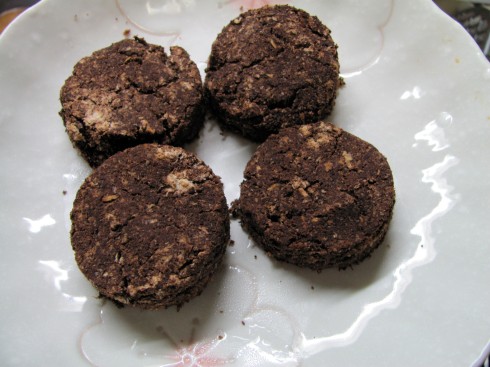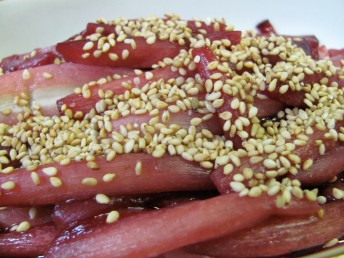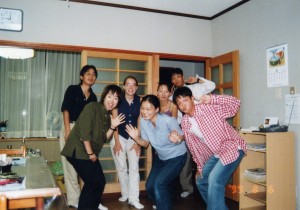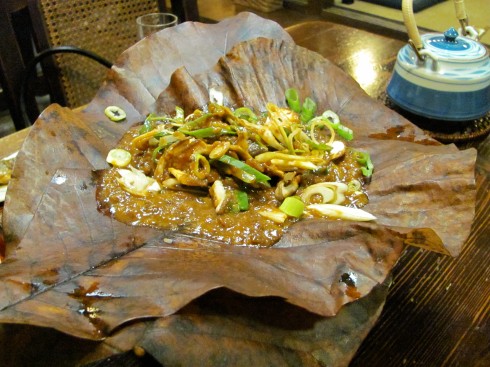I’ll Make It Myself!: Kitchen Library: What I Ate on New Year’s Break, Part 1
L.M. Zoller (CIR Ishikawa-ken, Anamizu, 2009-11) is the editor of The Ishikawa JET Kitchen: Cooking in Japan Without a Fight. A writer and web administrator for The Art of Travel, ze also writes I’ll Make It Myself!, a blog about food culture in Japan, and curates The Rice Cooker Chronicles, a series of essays by JETs and JET alumni on the theme of cooking/eating and being alone in Japan.
New Rice Cooker Chronicles submissions always welcome. Just e-mail it to jetwit [at] jetwit.com.
We stayed local with friends for the New Year, and after we exhausted our list of our favorite cafes one by one as they closed for the holidays, we holed up in the apartment and cooked up a storm. [Featuring korogaki, fuku-ume, nabe and more delicious Japanese dishes!]
Mochi Making
Posted by Benjamin Martin, a 5th year JET in Okinawa, publisher of the blog MoreThingsJapanese.com and author of the YA fantasy novel Samurai Awakening (Tuttle).
It’s the New Year, and in Japan that means its time for mochi! Mochi is a Japanese treat made from pounded rice. While mochi is now eaten throughout the year, it’s a favorite tradition during the New Year’s season. It’s generally served as a stuffed dumpling with fillings varying by region, taste, and tradition. On the left is a sweet bean filled mochi served on a getto leaf in Okinawa.
More on Mochi
In Japan, a lot of events have their origins in times when most villager’s diets consisted of very simple food. A long time ago, when rice was used as a currency, most Japanese only got to eat rice on special occasions. A condensed rice treat then, would have more calories, and be even more special. Eating mochi on new years “to ensure health in the new year” was almost literal. It was like a version of ancient Japanese powerbar. One Japanese story, Momotaro, tells of the young peach boy offering rice based treats to ensure help in a quest. Such legends show the how the traditions came to be. Today mochi is still an import part of New Year’s celebrations. It forms the centerpiece for the offering at many shrines.
Mochi takes time, energy, and to really do it right, community. All of these things tie into most Japanese celebrations. The act of creating and eating mochi brings people together for a shared experience, while also acting as an offering for the town’s, family’s, or individual’s ancestors.
Unfortunately, mochi has a dark side as well. Every year, several people are hospitalized due to their consumption of the sticky treat and often a few die. Be careful!
To learn about how mochi is made visit MoreThingsJapanese.com
As a special thank you to all my readers, followers, and friends I have released the first of the Jitsugen Samurai Diaries as a free ebook. Checkout The Tanner’s Daughter on Smashwords.
I’ll Make It Myself!: Curried Cauliflower with Tuna
L.M. Zoller (CIR Ishikawa-ken, Anamizu, 2009-11) is the editor of The Ishikawa JET Kitchen: Cooking in Japan Without a Fight. A writer and web administrator for The Art of Travel, ze also writes I’ll Make It Myself!, a blog about food culture in Japan, and curates The Rice Cooker Chronicles, a series of essays by JETs and JET alumni on the theme of cooking/eating and being alone in Japan.
New Rice Cooker Chronicles submissions always welcome. Just e-mail it to jetwit [at] jetwit.com.
I used to refer to cauliflower as “broccoli’s sad cousin.” Years of veggie trays at family functions taught me that dip does not make raw cauliflower taste good. A month of a “let’s try new vegetables” experiment in high school taught me that no amount of cheese will make me touch boiled cauliflower. (Seriously. There are some things even cheese can’t fix.)
At some point last year, everyone on the Internet seemed to having a foodgasm about using mashed cauliflower as an alternative to mashed potatoes, and as I was snarking away*, my husband revealed that he likes cauliflower.
Whoa whoa whoa. Back up there.
Local Industrial Festival Reveals a Wealth of Culture
Posted by Benjamin Martin, a 5th year JET in Okinawa, publisher of the blog MoreThingsJapanese.com and author of the YA fantasy novel Samurai Awakening (Tuttle).
The industrial Fair, or sangyo matsuri in Japanese, is a fixture in the annual event calendar on my island. From the English translation you might think of cars, heavy manufacturing, and other well-known industry. In Japan, though, many products are made by very small local companies rather than in large factories. Even when big factories are necessary, there are often many small shops acting as suppliers. Taken to a further level, small rural communities without those major industries often have a vibrant industrial community supporting local needs. You might be surprised to learn about all the things going on around you in small local Japan.
Recently, our island had its yearly sangyo matsuri, and event designed to inform locals about the various products made on Kumejima and also to sell those products. One of the local kaizen (community) centers was taken over by scores of tables and activities for everyone to enjoy.
Checkout MoreThingsJapanese.com for more photos and a video on the Agricultural, Oceanic, and Cultural sights at this unique event.
I’ll Make It Myself!: Whole-Wheat Ginger-Squash Muffins with Chocolate Chips
L.M. Zoller (CIR Ishikawa-ken, Anamizu, 2009-11) is the editor of The Ishikawa JET Kitchen: Cooking in Japan Without a Fight. A writer and web administrator for The Art of Travel, ze also writes I’ll Make It Myself!, a blog about food culture in Japan, and curates The Rice Cooker Chronicles, a series of essays by JETs and JET alumni on the theme of cooking/eating and being alone in Japan.
New Rice Cooker Chronicles submissions always welcome. Just e-mail it to jetwit [at] jetwit.com.
One last(?) squash purée recipe for the season!
I live in a country where the only cold cereals available at regular grocery stores (Tokyo Metro, you don’t count) are frosted flakes and cocoa puffs.* As a result, I’ve learned to make a variety of breakfast foods. I’m actually not sure how I only ended up with one muffin recipe on the blog onsidering the frequency with which we eat them at home. Muffins are the ideal food for the Japanese kitchen: their size means they cook through easily, unlike some quick breads; silicone muffin cups are easy to find; and the infinite variations you can make means you can adapt them to whatever flours (including gluten-free), milk, or seasonal fruit you can find in your area. Plus, they’re just fun to eat.
I’ll Make It Myself: The Word of the Day is Spatchcock: Thanksgiving 2012
L.M. Zoller (CIR Ishikawa-ken, Anamizu, 2009-11) is the editor of The Ishikawa JET Kitchen: Cooking in Japan Without a Fight. A writer and web administrator for The Art of Travel, ze also writes I’ll Make It Myself!, a blog about food culture in Japan, and curates The Rice Cooker Chronicles, a series of essays by JETs and JET alumni on the theme of cooking/eating and being alone in Japan.
New Rice Cooker Chronicles submissions always welcome. Just e-mail it to jetwit [at] jetwit.com.
“I’m going to spatchcock the turkey.” “Excuse me?”
“If I spatchcock the turkey–WHY ARE YOU BLUSHING?”
“So, I’ve decided to spatchcock the turkey.” “Is that some sort of fandom thing about Benedict Cumberbatch?”
Despite its unfortunate name, spatchcocking is simply a way of butterflying a turkey so it will cook faster…
Click HERE to read more.
I’ll Make It Myself: Kitchen Library – 9.24.2012
L.M. Zoller (CIR Ishikawa-ken, Anamizu, 2009-11) is the editor of The Ishikawa JET Kitchen: Cooking in Japan Without a Fight. A writer and web administrator for The Art of Travel (formerly The Art of Japan: Kanazawa & Discover Kanazawa), ze also writes I’ll Make It Myself!, a blog about food culture in Japan, and curates The Rice Cooker Chronicles, a series of essays by JETs and JET alumni on the theme of cooking/eating and being alone in Japan.
New Rice Cooker Chronicles submissions always welcome. Just e-mail it to jetwit [at] jetwit.com.

Welcome, new subscribers! I seem to have jumped from 20 email subscribers to 90 over the last week. I would love it if you commented to tell me how you found this blog and what kind of content most interests you–recipes? restaurant reviews? rants? Thank you for reading!
I’ll Make It Myself!: “Korinky Squash Chijimi”
L.M. Zoller (CIR Ishikawa-ken, Anamizu, 2009-11) is the editor of The Ishikawa JET Kitchen: Cooking in Japan Without a Fight. A writer and web administrator for The Art of Travel (formerly The Art of Japan: Kanazawa & Discover Kanazawa), ze also writes I’ll Make It Myself!, a blog about food culture in Japan, and curates The Rice Cooker Chronicles, a series of essays by JETs and JET alumni on the theme of cooking/eating and being alone in Japan.
New Rice Cooker Chronicles submissions always welcome. Just e-mail it to L.M. at jetwit [at] jetwit.com.
When I mentioned eating all that squash, you didn’t think I’d leave you hanging, did you?

Korinky (konrinkî, コリンキー) is a strange little squash. I bought it without recognizing the name, since many orange squashes are more or less interchangeable, and to my horror, I found no information on it in English other than this page, but apparently these round or football-shaped brindled beauties can be eaten raw! It’s not bad–reminds me of a cross between a fuyu persimmon (color and texture) and a squash. I had no idea what to do with it, so I turned to facebook and Cookpad before settling on this recipe, which I tweaked to suit my palate.
I’ll Make It Myself!: My Favorite Bamboo-Shoot (Takenoko) Recipes
L.M. Zoller (CIR Ishikawa-ken, Anamizu, 2009-11) is the editor of The Ishikawa JET Kitchen: Cooking in Japan Without a Fight. A writer and web administrator for The Art of Japan: Kanazawa and Discover Kanazawa, ze also writes I’ll Make It Myself!, a blog about food culture in Japan, and curates The Rice Cooker Chronicles, a series of essays by JETs and JET alumni on the theme of cooking/eating and being alone in Japan.
New Rice Cooker Chronicles submissions always welcome. Just e-mail it to jetwit [at] jetwit.com.

Early May means fresh bamboo shoots are in season again here in Ishikawa, and I received not one but three lovely shoots from my friends and coworkers this year! 2012 is apparently a bumper year for bamboo in the forests and in my kitchen.
Whether you purchased or received fresh bamboo, one large shoot can seem like a lot to cook up. The best English-language resource for cooking bamboo is, in my opinion, Makiko Itoh’s Just Hungry. The reason why I have only one bamboo recipe on this site is because I always use hers! What I do have to offer is how to cook raw bamboo, my master list of bamboo recipes, comments, and my own photos. Enjoy!
I’ll Make It Myself!: “Japanese Street Food and Foodpia Land 2012 (フードピアランド2012)”
L.M. Zoller (CIR Ishikawa-ken, Anamizu, 2009-11) is the editor of The Ishikawa JET Kitchen: Cooking in Japan Without a Fight. A writer and web administrator for The Art of Japan: Kanazawa and Discover Kanazawa, ze also writes I’ll Make It Myself!, a blog about food culture in Japan, and curates The Rice Cooker Chronicles, a series of essays by JETs and JET alumni on the theme of cooking/eating and being alone in Japan.
New submissions always welcome. Just e-mail it to jetwit [at] jetwit.com.
I’ve noticed an increased interest by foreign bloggers and media regarding Japan’s (read: Tokyo, Kyoto) street food culture in the last month, and as I was at a large food fair in Kanazawa, I figured it was time to add my comments and photos to the table.

CLICK HERE to read the full post.
The Rice Cooker Chronicles: “Broccoli Lover Learns to BBQ, Part 1” by Clara Solomon
The Rice Cooker Chronicles is a series of essays by JETs and JET alumni on the theme of cooking/eating and being alone in Japan. The brain-child of JETwit founder Steven Horowitz (Aichi-ken, Kariya-shi, 1992-94) (and inspired by the book Alone in the Kitchen with an Eggplant), this series is curated by L.M. Zoller (CIR Ishikawa-ken, Anamizu, 2009-11), the editor of The Ishikawa JET Kitchen: Cooking in Japan Without a Fight. A writer and web administrator for The Art of Japan: Kanazawa and Discover Kanazawa, ze also writes I’ll Make It Myself!, a blog about food culture in Japan.
New submissions always welcome. Just e-mail it to jetwit [at] jetwit.com.
*****
Broccoli Lover Learns to BBQ
Part 1
by Clara Solomon (CIR, Nichinan-cho, Tottori-ken; 1999-2001), the Director of Counseling & Career Development at the Office of Career Services at New York University School of Law. She previously worked for the Japan External Trade Organization, specializing in trade relations between Japan and Latin America. She lives in Queens with her husband and twin daughters.
Many of my experiences in Japan are tied up in the experience of food and cooking. Sure, I have my fill of the standard repertoire of “how many weird things will the American try?” My favorite of those is the night I was out at a new inn in my town, one that specialized in fresh, local food, with a “high end rustic” slant. So, I’m out with some co-workers enjoying a truly delicious meal, when they put a plate of glistening, dark red sashimi before me and say “to-rai, to-rai” (try, try). I wasn’t quite sure what this fish was, it was darker red than any tuna I’d ever seen, so dark it was almost purple, or black. There were thick veins of white fatty meat running through each piece – it almost looked like raw beef, though I could tell from the smell and texture that it was fish. “What is this?” I innocently asked, knowing full well that they wouldn’t tell me until I ate it. This game was a favorite of my colleagues, and they again said “to-rai.” So, I tried it. The minute I popped the full piece in my mouth, the entire table burst out with giggles and choruses of “Greeenpeesu! Greenpeesu!” Yes, Greenpeace. Turns out, I was eating endangered whale, the fishing and eating of which Japan has long been at odds with environmental groups like Greenpeace over (not to mention UN conventions, and the opinion of much of the rest of the world, minus Norway and the Inuit). How was it, you ask? Honestly, not that memorable. For one, it was extremely cold, indicating that it had probably been frozen and shipped to my town from somewhere further south (so much for eating local). For two, I think I would have rather had a piece of fatty tuna, whose rich, buttery flavor far outshone this piece of whale.
I could go on for pages regaling you with stories about the strange things I was given to eat, and the strange situations in which I found myself eating them (wild boar on live TV, anyone?). But, when I think back to the essence of my eating, drinking and cooking in Japan, those are only the warm up acts, the comedy routines that politicians put into the beginning of their stump speeches to play to the base and entice the crowds to stick around for the meat and potatoes (not that I had a lot of meat and potatoes in Japan…). My story of food in Japan is one of cooking and sharing, and gaining not only friends, but also self confidence in the process. Read More
I’ll Make It Myself – Travel Checklist: Local Foods in Hida-Takayama, Part 1
L.M. Zoller (CIR Ishikawa-ken, Anamizu, 2009-11) is the editor of The Ishikawa JET Kitchen: Cooking in Japan Without a Fight. A writer and translator for The Art of Japan: Kanazawa and Discover Kanazawa, ze also writes I’ll Make It Myself!, a blog about food culture in Japan.
Travel Checklist: Local Foods in Hida-Takayama, Part 1
In September, a friend and I traveled to Takayama, about 3 hours from Kanazawa. Located in Gifu near the border of Nagano, the old towns of Hida (飛騨) and Takayama (高山)are a food tourist’s paradise. Since the town is quite small, most of these foods can be found in stands or restaurants near Takayama Station and nearby morning markets.
CLICK HERE to read the full post.
I’ll Make It Myself! – Mini Okara Gateaux Chocolat
L.M. Zoller (CIR Ishikawa-ken, Anamizu, 2009-11) is the editor of The Ishikawa JET Kitchen: Cooking in Japan Without a Fight. A writer and translator for The Art of Japan: Kanazawa and Discover Kanazawa, ze also writes I’ll Make It Myself!, a blog about food culture in Japan.
Mini Okara Gateaux Chocolat
While looking for recipes the first time I bought okara, I had found several for okara gateaux. This recipe is the result of experimenting with a number of these, particularly with the amount of sugar and cocoa. The texture is quite different than a traditional chocolate gateau, but if you like desserts that have been remade with healthier ingredients (tofu, soy milk, etc.), this is bound to be a hit.

CLICK HERE to read the full post.
I’ll Make It Myself! – Aka-Zuiki Quick Pickles
Editor’s Note: I’ll Make It Myself is a blog about food culture and cooking for yourself in Japan by Ishikawa-based JET alum L.M. Zoller. We’re very pleased to share selected posts on JETwit as well.
L.M. Zoller (CIR Ishikawa-ken, Anamizu, 2009-11) is the editor of The Ishikawa JET Kitchen: Cooking in Japan Without a Fight. A writer and translator for The Art of Japan: Kanazawa and Discover Kanazawa, ze also writes I’ll Make it Myself!, a blog about food culture in Japan.
Hello, JETwit! I’m pleased to introduce my food blog I’ll Make it Myself: An Expat Career Woman’s Love Affair with Things Culinary. I cover a wide range of topics on this blog, including Japanese recipes, recipes adapted for Japan, local food culture, and restaurant reviews. A little about me: I’m obsessed with kabocha and oatmeal; I go through cinnamon like a champ; and I’m constantly on the hunt for good microbrews–the darker, the better. Many of my recipes and reviewed restaurants are vegetarian-friendly, and I try to keep things fairly healthy. Today, I’m posting a recent entry about Kaga heirloom vegetables, a recipe for gorgeous, quick, and delicious Japanese-style pickles.
Aka-Zuiki Quick Pickles (Red-Taro-Stem Vinegar Pickles)
Japanese food traditionally includes a lot of tsukemono (漬け物), or pickles. The first thing most Americans will think of when you say pickles is dill (cucumber) pickles that go with sandwiches; however, pickles are any vegetable that has been preserved with brining. Japanese pickles cover a wide range of base ingredients, including carrots, cucumbers, ginger, and plums; as well as a wide variety of pickling styles: salt, miso, vinegar, nuka (rice bran), and more. Some recipes call for the pickling mixture and vegetables (or fruit) to be aged overnight or for several months, but this recipe can be consumed right after cooking!

CLICK HERE to read the full post.
Vote for ‘Herbivores’ on Food2
Hi, it’s your Jetwit webmaster Lee-Sean Huang (Oita-ken ’03-’06) here. I have a quick favor to ask you all.
“Herbivores,” the stop-motion animation video that I made with my friend Elizabeth Fuller last year has made it to the top 10 semifinals of the First Annual Food2 Summer Challenge. We desperately need your votes to help us win the grand prize. Please vote for us here. You need to sign in to vote, but you can log in using your Facebook or MySpace account. It only takes a minute.
Thanks so much for your help!










